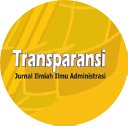Efektivitas Alokasi Dana Desa Terhadap Pemberdayaan Masyarakat Di Desa Condongcatur Kabupaten Sleman
DOI:
https://doi.org/10.31334/transparansi.v7i1.3307Keywords:
Effectiveness, Village fund allocation (ADD), Empowerment, Condongcatur Village, Sleman RegencyAbstract
Effectiveness of Village Fund Allocation on Community Empowerment in Condongcatur Village, Sleman Regency This study examines the management of village fund allocation (ADD). This study uses the theory of effectiveness from Gibson where there are two approaches in assessing effectiveness according to objectives and systems. Concepts that reflect effectiveness include: a) The entire input cycle of the output process, b) reflecting the relationship between the organization and the environment. Furthermore, community empowerment is an effort to use and manage community resources more effectively and efficiently covering a) input or input aspects (facilities and infrastructure and human resources), b) process aspects (implementation of monitoring and supervision), (c) output/ouput (target achievement, effectiveness and efficiency). In essence, the purpose of empowerment is to form individuals and communities to become independent. This study uses a type of qualitative descriptive research. The results of research on the effectiveness of village fund allocation on community empowerment in Padukuhan Gejayan, the implementation of the village fund budget is running well in community institutions, planning, dukuh and RW/RT given according to the needs, priorities and potential of the region in seeking community empowerment. The supporting and inhibiting factors in the target group are the effectiveness of village funds with not optimal outcomes from the community empowerment program. ABSTRAK Penelitian ini meneliti tentang pengelolaan alokasi dana desa (ADD). Penelitian ini menggunakan teori efektivitas Gibson dimana terdapat dua pendekatan dalam menilai efektivitas menurut tujuan dan sistem. Konsep yang mencerminkan efektivitas antara lain: a) seluruh siklus input proses output, b) mencerminkan hubungan antara organisasi dengan lingkungan. Selanjutnya, pemberdayaan masyarakat merupakan upaya pemanfaatan dan pengelolaan sumber daya masyarakat secara lebih efektif dan efisien yang meliputi a) aspek input atau masukan (sarana dan prasarana serta sumber daya manusia), b) aspek proses (pelaksanaan monitoring dan pengawasan), (c) aspek output/keluaran (pencapaian target, efektifitas dan efisiensi). Pada intinya, tujuan pemberdayaan adalah membentuk individu dan masyarakat menjadi mandiri. Penelitian ini menggunakan jenis penelitian kualitatif deskriptif. Hasil penelitian efektivitas alokasi dana desa terhadap pemberdayaan masyarakat di Padukuhan Gejayan, pelaksanaan anggaran dana desa berjalan dengan baik pada lembaga kemasyarakatan, perencanaan, dukuh dan RW/RT yang diberikan sesuai dengan kebutuhan, prioritas dan potensi wilayah dalam mengupayakan pemberdayaan masyarakat. Faktor pendukung dan penghambat pada kelompok sasaran yaitu efektivitas dana desa dengan hasil yang belum optimal dari program pemberdayaan masyarakat.References
Ardiansyah, D (2017). Efektivitas Pengelolaan Keuangan Alokasi Dana Desa (ADD) Di Desa Kedayunan Kecamatan Kabat Kabupaten Banyuwangi
Boedijono, Galih Wicaksono, Yeni Puspita, Sandika Cipta Bidhari, Nurcahyaning Dwi Kusumaningrum, Venantya Asmandi (2019). Efektivitas Pengelolaan Dana Desa Untuk Pembangunan Dan Pemberdayaan Masyarakat Desa Di Kabupaten Bondowoso. Jurnal Riset Manajemen dan Bisnis (JRMB) Fakultas Ekonomi UNIAT.
Enza Resdiana, Irma Irawati, (2020) Efektivitas Dana Desa Dalam Mendukung Pemberdayaan Masyarakat Didesa Marengan Daya Kabupaten Sumenep. Jurnal Publik Corner Fisip Universitas Wiraraja.
Fisabililah, F. F., Azizatun Rochmatul Nisaq, & Siti Nurrahmawati. (2020). Efektivitas Pengelolaan Dana Desa Dalam Pemberdayaan Masyarakat. Jurnal Ilmu Administrasi Publik.
Hasiabuan, Malayu S.P. (2012) Manajemen Sumber Daya Manusia. Jakarta PT Bumi Aksara
Jopang, Utha, A., & Harianto, E. 2018. Pelaksanaan Alokasi Dana Desa (ADD) Dalam Bidang Pemberdayaan masyarakat dikabupaten Konawe. Journal publicuho, https://doi.org/35817/jpu.v1i2.5826
Jovanca Mamuja, Freddy Kawatu, Anita Kambey (2021). Efektivitas Pengelolaan Alokasi Dana Desa Sea Satu Kecamatan Pineleng Kabupaten Minahasa. Jurnal Akuntansi Manado
Mardiasmo, (2017). Perpajakan Edisi Terbaru, Yogyakarta. Andi
Nurhayati, D (2018). Efektivitas Pengelolaan Alokasi Dana Desa Dalam Upaya Meningkat Pembangunan Dan Pemberdayaan Masyarakat. Jurnal Pendidikan Ekonomi, Kewirausahaan, Bisnis, dan Manajemen
Rahma Yulita (2016). Efektivitas Pelaksanaan Penggunaan Alokasi Dana desa (ADD) Di Desa Setako Raya Kecamatan Peranap Kabupaten Indragitih Hulu. Jurusan Ilmu Adminitrasi Fakultas Ilmu Sosial dan Ilmu Politik.
Ramadani, R. (2019). Efektivitas Program Alokasi Dana Desa Dalam Pemberdayaan Masyarakat Di Desa Liang ULU Kecamatan Kota Bangun Kabupaten Kutai Kartanegara. Journal Ilmu Pemerintah
Ramdhani, A., & Muhammad Ali Ramdhani. (2017). Konsep Umum Pelaksanaan Kebijakan Publik. Journal Publik.
Utha, J. A., & Eko Harianto. (2018). Pelaksanaan Alokasi Dana Desa dalam bidang Pemberdayaan Masyarakat Di Konawe. Jurnal Publikcuho
Yohanes Arianto Budi Nugroho. (2014). Manajemen Sumber Daya Manusia “Mengelola SDM Secara Profesionalâ€
Downloads
Published
Issue
Section
License

This work is licensed under a Creative Commons Attribution-ShareAlike 4.0 International License
Please find the rights and licenses in Transparansi : Jurnal Ilmiah Ilmu Administrasi By submitting the article/manuscript of the article, the author(s) agree with this policy. No specific document sign-off is required.
- License
The commercial use of the article will be governed by the Creative Commons Attribution license as currently displayed on Creative Commons Attribution-ShareAlike 4.0 International License.
2. Author(s)' Warranties
The author warrants that the article is original, written by stated author(s), has not been published before, contains no unlawful statements, does not infringe the rights of others, is subject to copyright that is vested exclusively in the author and free of any third party rights, and that any necessary written permissions to quote from other sources have been obtained by the author(s).
3. User Rights
Transparansi : Jurnal Ilmiah Ilmu Administrasi spirit is to disseminate articles published are as free as possible. Under the Creative Commons license, Transparansi : Jurnal Ilmiah Ilmu Administrasi permits users to copy, distribute, display, and perform the work for non-commercial purposes only. Users will also need to attribute authors and Transparansi : Jurnal Ilmiah Ilmu Administrasi on distributing works in the journal and other media of publications.
4. Co-Authorship
If the article was jointly prepared by more than one author, any authors submitting the manuscript warrants that he/she has been authorized by all co-authors to be agreed on this copyright and license notice (agreement) on their behalf, and agrees to inform his/her co-authors of the terms of this policy. Transparansi : Jurnal Ilmiah Ilmu Administrasi will not be held liable for anything that may arise due to the author(s) internal dispute. Transparansi : Jurnal Ilmiah Ilmu Administrasi will only communicate with the corresponding author.
5. Miscellaneous
Transparansi : Jurnal Ilmiah Ilmu Administrasi will publish the article (or have it published) in the journal if the article’s editorial process is successfully completed. Transparansi : Jurnal Ilmiah Ilmu Administrasi editors may modify the article to a style of punctuation, spelling, capitalization, referencing and usage that deems appropriate. The author acknowledges that the article may be published so that it will be publicly accessible and such access will be free of charge for the readers as mentioned in point 3.
Every accepted manuscript should be accompanied by "Copyright Transfer Agreement"prior to the article publication.











